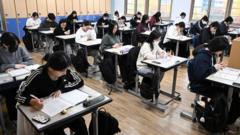Trump signals a return to aggressive trade tactics, putting Japan, South Korea, and five other nations under pressure with looming tariff increases.
**Trump's Aggressive New Tariff Strategy Targets Seven Nations**
**Trump's Aggressive New Tariff Strategy Targets Seven Nations**
In a bold move, President Trump threatens significant tariffs on multiple countries if trade agreements are not reached by August 1.
By Christine Zhang and Tony Romm
July 7, 2025, 4:44 p.m. ET
President Trump has delivered stern warnings to Japan, South Korea, and five additional countries, stating they will incur hefty tariffs starting August 1 unless swift trade agreements are established. This latest development marks a resurgence in the president's combative trade strategies, with more countries expected to receive tariff threats in the days to come.
The new tariffs, which were outlined in official letters to leaders of the affected nations and shared through social media, replace previously proposed high duties that were announced in April and subsequently paused for 90 days. This grace period was largely aimed at forging advantageous trade deals worldwide. However, progress has been minimal, falling short of the administration's ambitious goal of "90 deals in 90 days," which is set to expire this Wednesday.
To extend the timeframe for negotiations, Trump plans to issue an executive order on Monday that will prolong the initial suspension while notifying affected countries of new tariffs set to take effect next month. The initial letters went out to Japan, South Korea, Malaysia, South Africa, Kazakhstan, Laos, and Myanmar. Notably, both Japan and South Korea are facing a 25 percent tariff, while Myanmar may face a staggering 40 percent tariff despite its small share in U.S. imports.
Moreover, Trump has warned these countries that tariff rates could rise further if they retaliate with their own import taxes or attempt to circumvent U.S. duties through other nations. In the upcoming days, more nations may receive tariff notifications related to earlier proposals made by the Trump administration in April, indicating a policy shift towards tougher stances in international trade negotiations.
Christine Zhang covers graphics and data journalism for The Times, while Tony Romm specializes in economic policies related to the Trump administration from Washington, D.C.
July 7, 2025, 4:44 p.m. ET
President Trump has delivered stern warnings to Japan, South Korea, and five additional countries, stating they will incur hefty tariffs starting August 1 unless swift trade agreements are established. This latest development marks a resurgence in the president's combative trade strategies, with more countries expected to receive tariff threats in the days to come.
The new tariffs, which were outlined in official letters to leaders of the affected nations and shared through social media, replace previously proposed high duties that were announced in April and subsequently paused for 90 days. This grace period was largely aimed at forging advantageous trade deals worldwide. However, progress has been minimal, falling short of the administration's ambitious goal of "90 deals in 90 days," which is set to expire this Wednesday.
To extend the timeframe for negotiations, Trump plans to issue an executive order on Monday that will prolong the initial suspension while notifying affected countries of new tariffs set to take effect next month. The initial letters went out to Japan, South Korea, Malaysia, South Africa, Kazakhstan, Laos, and Myanmar. Notably, both Japan and South Korea are facing a 25 percent tariff, while Myanmar may face a staggering 40 percent tariff despite its small share in U.S. imports.
Moreover, Trump has warned these countries that tariff rates could rise further if they retaliate with their own import taxes or attempt to circumvent U.S. duties through other nations. In the upcoming days, more nations may receive tariff notifications related to earlier proposals made by the Trump administration in April, indicating a policy shift towards tougher stances in international trade negotiations.
Christine Zhang covers graphics and data journalism for The Times, while Tony Romm specializes in economic policies related to the Trump administration from Washington, D.C.




















